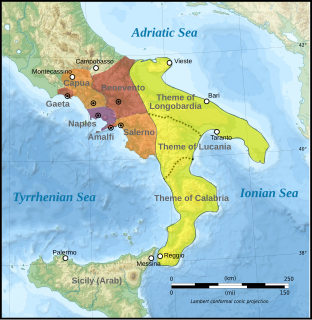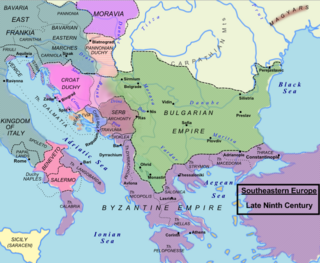The 830s decade ran from January 1, 830, to December 31, 839.
Year 876 (DCCCLXXVI) was a leap year starting on Sunday of the Julian calendar.

Louis II, sometimes called the Younger, was the king of Italy and Holy Roman Emperor from 844, co-ruling with his father Lothair I until 855, after which he ruled alone. Louis's usual title was imperator augustus, but he used imperator Romanorum after his conquest of Bari in 871, which led to poor relations with the Eastern Roman Empire. He was called imperator Italiae in West Francia while the Byzantines called him Basileus Phrangias. The chronicler Andreas of Bergamo, who is the main source for Louis's activities in southern Italy, notes that "after his death a great tribulation came to Italy."

The Aghlabids were an Arab dynasty of emirs from the Najdi tribe of Banu Tamim, who ruled Ifriqiya and parts of Southern Italy, nominally on behalf of the Abbasid Caliph, for about a century, until overthrown by the new power of the Fatimids.

The history of the Italian peninsula during the medieval period can be roughly defined as the time between the collapse of the Western Roman Empire and the Italian Renaissance.

The Duchy of Benevento was the southernmost Lombard duchy in the Italian Peninsula that was centred on Benevento, a city in Southern Italy. Lombard dukes ruled Benevento from 571 to 1077, when it was conquered by the Normans for four years before it was given to the Pope. Being cut off from the rest of the Lombard possessions by the papal Duchy of Rome, Benevento was practically independent from the start. Only during the reigns of Grimoald, King of the Lombards and the kings from Liutprand on was the duchy closely tied to the kingdom. After the fall of the kingdom, however, alone of Lombard territories it remained as a rump state and maintained its de facto independence for nearly 300 years though it was divided after 849.

The De Ceremoniis is the conventional Latin name for a Greek book of ceremonial protocol at the court of the Byzantine emperors in Constantinople. Its Greek title is often cited as Ἔκθεσις τῆς βασιλείου τάξεως, taken from the work's preface, or Περὶ τῆς Βασιλείου Τάξεως. In non-specialist English sources, it tends to be called the Book of Ceremonies of Constantine VII Porphyrogennetos, a formula used by writers including David Talbot Rice and the modern English translation.

The Ludwigslied is an Old High German (OHG) poem of 59 rhyming couplets, celebrating the victory of the Frankish army, led by Louis III of France, over Danish (Viking) raiders at the Battle of Saucourt-en-Vimeu on 3 August 881.

Longobardia was a Byzantine term for the territories controlled by the Lombards in Italy. In the 9th-10th centuries, it was also the name of a Byzantine military-civilian province known as the Theme of Longobardia located in southeastern Italy.

Adelchis was the son of Radelchis I, Prince of Benevento, and successor of his brother Radelgar in 854.
Lambert I was the duke and margrave of Spoleto on two occasions, first from 859 to 871 and then from 876 to his death.

The history of Islam in Sicily and Southern Italy began with the first Arab settlement in Sicily, at Mazara, which was captured in 827. The subsequent rule of Sicily and Malta started in the 10th century. The Emirate of Sicily lasted from 831 until 1061, and controlled the whole island by 902. Though Sicily was the primary Muslim stronghold in Italy, some temporary footholds, the most substantial of which was the port city of Bari, were established on the mainland peninsula, especially in mainland Southern Italy, though Muslim raids, mainly those of Muhammad I ibn al-Aghlab, reached as far north as Naples, Rome and the northern region of Piedmont. The Muslim raids were part of a larger struggle for power in Italy and Europe, with Christian Byzantine, Frankish, Norman and local Italian forces also competing for control. Muslims were sometimes sought as allies by various Christian factions against other factions.

The Muslim conquest of Sicily began in June 827 and lasted until 902, when the last major Byzantine stronghold on the island, Taormina, fell. Isolated fortresses remained in Byzantine hands until 965, but the island was henceforth under Muslim rule until conquered in turn by the Normans in the 11th century.

The Emirate of Bari was a short-lived Islamic state ruled by Berbers. It was ruled from the south Italian city of Bari from 847 to 871. It was the most lasting episode in the history of Islam in peninsular southern Italy.
The former Roman Catholic Diocese of Sant'Agata de' Goti, in the Province of Benevento, Campania, southern Italy, was a suffragan of the Archdiocese of Benevento from 969 till its 1986 merger into the Diocese of Cerreto Sannita-Telese-Sant'Agata de' Goti.
Abu'l-Abbas Muhammad I ibn al-Aghlab was the fifth emir of the Aghlabid dynasty, who ruled over Ifriqiya, Malta, and most of Sicily from 841 until his death. He also led the raid of Rome.
Niketas Oryphas or Oöryphas was a distinguished Byzantine official, patrikios, and admiral under the Byzantine emperors Michael III and Basil I the Macedonian, who achieved several naval victories against the Cretan Saracen raiders.

The Battle of Stelai was a naval battle fought in 880 between the Byzantine and Aghlabid fleets off the southern Italian peninsula. The battle was a major Byzantine victory. Its location is disputed, hence it is also known as the First Battle of Milazzo or the Battle of Punta Stilo in modern literature.

The Siege of Ragusa by the Aghlabids of Ifriqiya lasted for fifteen months, beginning in 866 until the lifting of the siege at the approach of a Byzantine fleet in 868. The failure of the siege and the re-appearance of the Byzantines in the region of Dalmatia signalled the beginning of new aggressive western policy by the new Byzantine emperor, Basil I. Its immediate effects were the re-establishment of Byzantine authority there in the form of the Theme of Dalmatia, and the beginning of the Christianization of the Slavs of the western Balkans, but within a few years it led to renewed Byzantine involvement and presence in southern Italy as well.
The Frankish emperor Louis II campaigned against the Emirate of Bari continuously from 866 until 871. Louis was allied with the Lombards of southern Italy from the start, but an attempt at joint action with the Byzantine Empire failed in 869. In the final siege of the city of Bari in 871, Louis was assisted by a Slavic fleet from across the Adriatic.